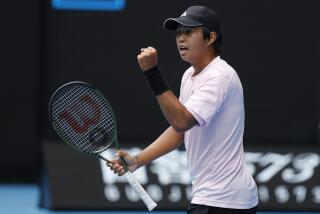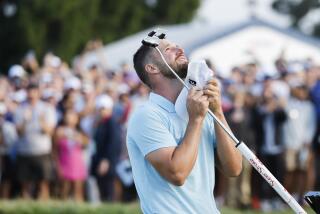Return to Grand Slam Glory : Rod Laver Was the Last Man to Sweep Four Major Titles and Thinks It Can Be Done Again
- Share via
Dark clouds threatened more rain as Australians Rod Laver and Tony Roche played for the U.S. Open championship on a grass court left soggy by morning showers. The start of the match had been delayed 95 minutes while a helicopter helped dry the court.
It was Sept. 8, 1969. Laver, 31, was seven years older than Roche and had lost five of seven matches to him that year. Eight months earlier, Roche had pushed him in the semifinals of the Australian Open before Laver won, 7-5, 22-20, 9-11, 1-6, 6-3, in 4 1/2 hours.
Laver won the Australian title before also winning the French Open and Wimbledon, moving him three-quarters of the way to a Grand Slam.
But Roche was determined to leave him short of his goal.
“I cheered for Rocket to make the Grand Slam in ’62 when I was a teen-ager,” Roche said at the time. “But I want to stop him this time.”
Roche opened a 5-4 lead in the first set at Forest Hills, N.Y., but Laver altered the course of the match simply by changing shoes. Switching from tennis shoes to spikes to improve his footing on the rain-slickened grass court, Laver completed his Grand Slam with a 7-9, 6-1, 6-2, 6-2 victory.
In 25 years since, no man has duplicated the feat, which Laver first accomplished in ‘62, matching the effort of Don Budge in 1938.
But many, Laver included, believe that Pete Sampras, 23, could join Laver, Budge, Maureen Connolly, Margaret Court and Steffi Graf as the sport’s only Grand Slam winners if he can convert his mastery on faster courts to the slower clay of the French Open, which starts Monday in Paris.
Sampras, who has already won major titles on hardcourts at the U.S. Open and Australian Open and on grass at Wimbledon, won the Italian Open this month, easily the most impressive of his two clay-court titles.
“With his game--he’s got a beautiful game, a tremendous serve; he can stay back or go into the net--it’s just a matter of whether he peaks at the right time,” said Laver, now 55 and living with Mary, his wife of 27 years, in Rancho Mirage. “That’s the all-important part of Pete’s game--to come in strong and fresh and stay determined.
“If that’s the case, he’s got every chance to win. The clay is probably his toughest test. There are some great players out there who prefer the European clay. It’s just a matter of playing your right game.”
Laver was at the top of his game in 1969, the first full year of the open era, and had plenty of incentive to show the world how well he could play. The major events were opened to professionals in 1968, so Laver was eligible to play in them for the first time since his 1962 Grand Slam, accomplished as an amateur.
His hope was to sweep.
“I went to Australia with that in mind,” said the left-handed redhead from Rockhampton.
Laver, in the pre-tiebreaker era, kept his dream alive by outlasting Roche in the two-hour second set of their semifinal match, which was played in 105-degree heat at Brisbane. Laver tried to beat the heat by draping cool, wet cabbage leaves inside his floppy sun hat.
“Fortunately, I grew up in that area and I knew what it was like,” Laver said. “You sort of have a mental feeling of what it’s going to take. After the match, you certainly are tired and beat, but it’s sort of a great feeling to come through a tough one like that.”
Without a questionable call, he might have fallen short. Laver, having lost in the third and fourth sets after serving for the match at 8-7 in the third, led in the fifth, 4-3, with each player having held serve.
In the eighth game, free-lance writer Paul Fein later reported, “Roche missed a volley, normally his forte, to fall behind, 15-30. That set up a huge pressure point and what would be one of the most famous--or rather infamous--line calls in tennis history. Roche spun his wickedly swerving southpaw serve into Laver’s body. Laver sliced his return crosscourt and seemingly just outside the singles sideline.
“When the official signaled safe, the usually mild-mannered Roche became furious. He turned around and queried him, ‘Did you actually make that call? Did you really see the ball? Do you think I stood out here for more than 4 1/2 hours to get a call like that?’ ”
Laver broke the crestfallen Roche, served out the match and didn’t have nearly as much trouble in the final, winning in straight sets over Andres Gimeno of Spain.
Although clay was far from his favorite surface, Laver also won rather easily at the French Open after surviving a two-set deficit in the second round against countryman Dick Crealy. Another Australian, Ken Roswall, fell in straight sets in the final. “I probably played my best tennis in the final,” Laver said. “And with that win, I felt a lot more secure (about winning the Grand Slam). The next two (major tournaments) were on grass, and that was my favorite surface.”
At Wimbledon, in a four-set final, Laver defeated countryman John Newcombe.
And so, it was on to the rain-soaked U.S. Open, where Laver survived a five-set match against Dennis Ralston in the round of 16--and the mushy courts--en route to earning the first prize of $16,000, increasing his take for the year to a then-record $106,000.
In the final, delayed by a day because of rain, Roche never changed out of his tennis shoes, despite the conditions. “His feeling was that he might get cramps because you tend not to slide as much, although I was still sliding in spikes,” Laver said. “But I found myself getting a little more confident as the match went on because you could always get to the ball (in spikes). The balls were very heavy and wouldn’t bounce very high, so you had to get there quickly.”
Twenty-five years later, Laver’s feat seems all the more remarkable because no man has been able to match it. “You have to be very fortunate to play your best tennis, bring yourself up to the peak four times during the year,” said Laver, who didn’t win another Grand Slam event after 1969.
None of the male players who have followed Laver have won all four major titles in their careers, much less a year. Bjorn Borg didn’t win the U.S. Open or the Australian Open, Newcombe and Jimmy Connors couldn’t win the French Open, John McEnroe never won the Australian Open or the French Open. Ivan Lendl has not won Wimbledon, and Boris Becker has not won the French Open.
“The new technology, with the bigger-headed rackets, allows the players to all play a lot better a lot quicker, so the competition becomes much more difficult,” Laver said. “And the depth of competition is probably the reason for no one coming through to win the Grand Slam.
“Back when I was playing, there were probably 20 or 30 (players) that you felt you’d better be very careful against. Today, there are probably 150.
“I thought somebody like Boris Becker, when he won Wimbledon at such a young age, would be a force to win them all. In some ways, you would have thought that one of the players would have put a whole year together and won all the majors.”
Laver said he hopes Sampras can do it.
“We know it’s a long way off,” Laver said, “but if he can pull it off, hopefully, I’ll be there first to shake his hand.”
More to Read
Go beyond the scoreboard
Get the latest on L.A.'s teams in the daily Sports Report newsletter.
You may occasionally receive promotional content from the Los Angeles Times.










